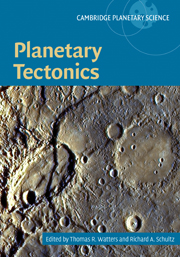Book contents
- Frontmatter
- Contents
- List of contributors
- Preface
- 1 Planetary tectonics: introduction
- 2 The tectonics of Mercury
- 3 Venus tectonics
- 4 Lunar tectonics
- 5 Mars tectonics
- 6 Tectonics of small bodies
- 7 Tectonics of the outer planet satellites
- 8 Planetary structural mapping
- 9 Strength and deformation of planetary lithospheres
- 10 Fault populations
- Index
- Plates
- References
2 - The tectonics of Mercury
Published online by Cambridge University Press: 30 March 2010
- Frontmatter
- Contents
- List of contributors
- Preface
- 1 Planetary tectonics: introduction
- 2 The tectonics of Mercury
- 3 Venus tectonics
- 4 Lunar tectonics
- 5 Mars tectonics
- 6 Tectonics of small bodies
- 7 Tectonics of the outer planet satellites
- 8 Planetary structural mapping
- 9 Strength and deformation of planetary lithospheres
- 10 Fault populations
- Index
- Plates
- References
Summary
Summary
Mercury has a remarkable number of landforms that express widespread deformation of the planet's crustal materials. Deformation on Mercury can be broadly described as either distributed or basin-localized. The distributed deformation on Mercury is dominantly compressional. Crustal shortening is reflected by three landforms, lobate scarps, high-relief ridges, and wrinkle ridges. Lobate scarps are the expression of surface-breaking thrust faults and are widely distributed on Mercury. High-relief ridges are closely related to lobate scarps and appear to be formed by high-angle reverse faults. Wrinkle ridges are landforms that reflect folding and thrust faulting and are found largely in smooth plains material within and exterior to the Caloris basin. The Caloris basin has an array of basin-localized tectonic features. Basin-concentric wrinkle ridges in the interior smooth plains material are very similar to those found in lunar mascon basins. The Caloris basin also has the only clear evidence of broad-scale, extensional deformation. Extension of the interior plains materials is expressed as a complex pattern of basin-radial and basin-concentric graben. The graben crosscut the wrinkle ridges in Caloris, suggesting that they are among the youngest tectonic features on Mercury. The tectonic features have been used to constrain the mechanical and thermal structure of Mercury's crust and lithosphere and to test models for the origin of tectonic stresses. Modeling of lobate scarp thrust faults suggests that the likely depth to the brittle–ductile transition (BDT) is 30 to 40 km.
- Type
- Chapter
- Information
- Planetary Tectonics , pp. 15 - 80Publisher: Cambridge University PressPrint publication year: 2009
References
- 8
- Cited by



